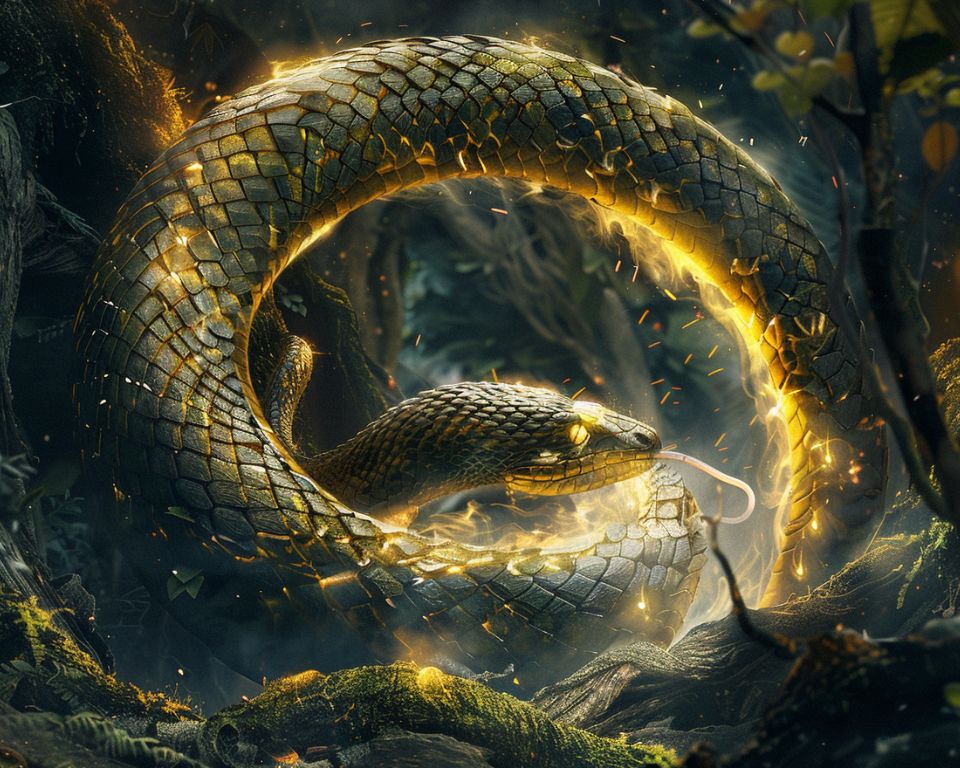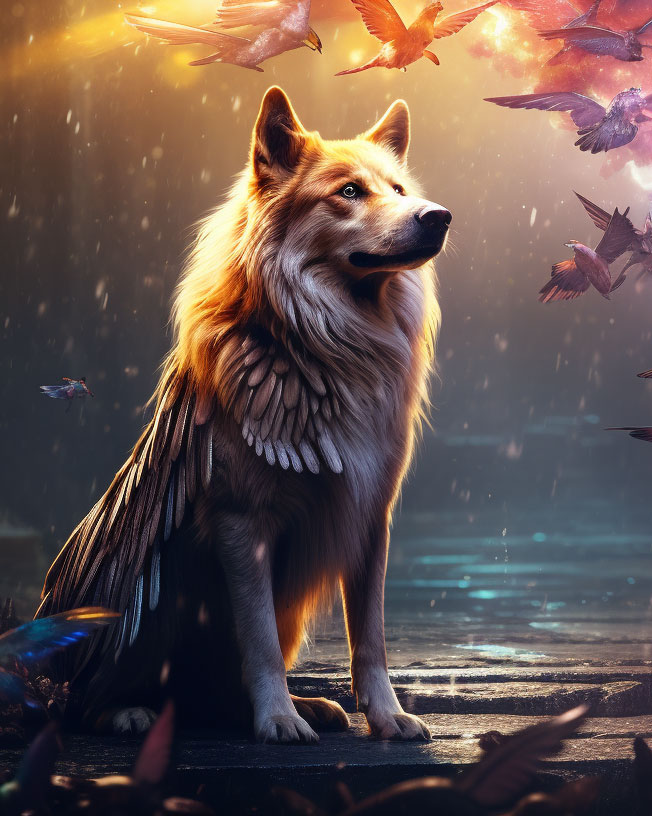When we dive into the world of symbols, one of the most captivating and ancient ones we encounter is the Ouroboros.
It’s a symbol that looks like a snake or a dragon eating its own tail, forming a circle and it commonly represents the cyclical nature of life, self-reflexivity, renewal, and the interconnectedness of all things.
In this article, I’m excited to take you on a journey through history to discover the origins of this symbol, explore its deep symbolism and meaning, see how it slides its way into modern culture, and uncover its spiritual and philosophical significance.
Whether you’ve seen this symbol in a book, a movie, or a piece of jewelry and wondered about its meaning, or you’re diving into esoteric and spiritual symbols out of pure curiosity, you’re in the right place.
Let’s unwrap the mystery of the Ouroboros together and find out why it continues to intrigue and inspire people around the world.
Key Takeaways
- The Ouroboros is an ancient symbol depicting a serpent or dragon eating its own tail, representing concepts such as eternity, the cycle of life and death, and the universe.
- Its origins trace back to ancient civilizations including Egypt and Greece, highlighting its universal appeal and deep historical significance.
- The symbolism of the Ouroboros varies, but it commonly represents the cyclical nature of life, self-reflexivity, renewal, and the interconnectedness of all things.
- In modern culture, the Ouroboros has found its place in literature, psychology, and pop culture, maintaining its relevance and adaptability through the ages.
- Spiritually and philosophically, the Ouroboros holds significant meaning in alchemy, Gnosticism, and other esoteric traditions, symbolizing the unity of opposites and the transmutation of the spirit.
Historical Origins
The Ouroboros has a fascinating journey through time, first making its mark in ancient Egypt and then winding its way into Greek culture.
Imagined as a serpent or dragon biting its own tail, this symbol was carved into the stone of Egyptian tombs as far back as the 14th century BCE. It was more than just art; it was a powerful representation of the cycle of life and death, and it mirrored the endless journey of the sun across the sky each day.
Ancient Egyptians weren’t the only ones entranced by this symbol; the ancient Greeks were too. They even gave it the name we use today, “Ouroboros,” which literally means “tail-devourer.”
For the Greeks, it also represented eternal cycles, touching on themes like rebirth and the flow of time. They wove this symbol into their philosophical discussions and alchemical writings, giving it even deeper significance.
The movement of the Ouroboros from the deserts of Egypt to the intellectual havens of Greece symbolizes its universal appeal and deep connection to human thought.
Across different settings and eras, it maintained its mystery and power, making it a timeless symbol that speaks to the eternal and cyclical nature of life itself.
Symbolism and Meaning
The Ouroboros isn’t just an ancient symbol; it’s a deep well of meaning, holding truths about the universe, life, and the very fabric of existence.
At its most basic, the serpent eating its own tail represents cycles – the eternal round of life, death, and rebirth. This cyclical nature mirrors the natural world, where seasons change, plants grow and die, and life continues in an everlasting loop.
But the Ouroboros goes deeper, touching on the unity of all things. It symbolizes the idea that the end is also the beginning, showing how life feeds into itself, in a perpetual state of renewal.
This concept resonates not only in nature but also within us, reflecting the continuous growth and change we experience throughout our lives.
The symbol also holds a mirror to the concept of infinity and the eternal.
By forming a circle, the Ouroboros embodies the infinite cycle of time, reminding us that everything is connected and that time is a continuous loop without beginning or end.
This idea of infinity invites us to contemplate the vastness of the universe and our place within it, encouraging a sense of unity with the cosmos.
In essence, the Ouroboros serves as a powerful reminder of life’s complexity, its cycles, and the interconnectedness of all things.
It encourages us to see beyond the surface, to understand the deeper rhythms of nature and existence, and to recognize the continuous cycle of renewal that is at the heart of life itself.
The Ouroboros in Modern Culture
Even though the Ouroboros comes from ancient times, it hasn’t lost its intrigue or significance. You can spot this symbol popping up in various corners of modern culture, from books and movies to logos and even video games.
Its adaptability and potent symbolism make it a favorite for storytellers and creators who wish to add layers of mystery, continuity, and depth to their works.
In literature, the Ouroboros is often used to symbolize the eternal cycle of life’s destruction and rebirth, a theme that resonates with many readers on a philosophical level.
It can represent the struggle with self-identity, the concept of time, or the cyclic nature of history. This makes it a powerful motif for exploring complex ideas and emotions.
Movies and TV shows also weave the Ouroboros into their narratives, sometimes using it as a visual clue to a plot’s cyclical or self-reflective nature.
It can hint at the interconnectedness of characters’ fates or the inevitable return to a narrative’s beginning, creating a rich tapestry of meaning that rewards attentive viewers.
In the realm of psychology, especially within Jungian perspectives, the Ouroboros symbolizes the idea of the self and the process of individuation.
Here, it represents the merging of the conscious and unconscious parts of the mind, leading to personal growth and realization of the self.
From these examples, it’s clear that the Ouroboros has woven its way deeply into the fabric of modern culture.
It continues to engage us, prompting reflections on beginnings and endings, the nature of life, and our place in the universe.
Spiritual and Philosophical Significance
The Ouroboros is not just a historical or cultural icon; it holds profound spiritual and philosophical significance, particularly in the realms of alchemy, Gnosticism, and other mystical traditions.
In these contexts, it symbolizes the unity of opposites, the harmonization of the duality of existence, portraying how seemingly contradictory elements can coexist and even depend on one another.
Alchemy views the Ouroboros as a representation of the alchemical process itself, the cycle of purification and rebirth necessary to achieve the Magnum Opus or the philosopher’s stone.
It signifies the eternal struggle and balance between the primal chaos and the perfect state, between mortality and divinity.
In Gnostic thought, the symbol reflects the soul’s journey and its return to divine completeness, encapsulating the endless struggle of spiritual enlightenment and the reunification with the One.
It illustrates the cyclical nature of spiritual growth and the eternal return to the source, emphasizing the importance of the inner journey and self-discovery.
The philosophical depth of the Ouroboros also touches on themes of eternal recurrence, as discussed by philosophers like Nietzsche, suggesting that life repeats itself infinitely, and what has happened will always recur.
This perspective invites individuals to contemplate the significance of their actions and the nature of existence in a cyclical universe.
Through these spiritual and philosophical lenses, the Ouroboros serves as a powerful reminder of the complexity of existence, the interdependence of all things, and the continuous cycle of death and rebirth.
It encourages us to reflect on our own spiritual journey, the balance of opposites within ourselves, and our connection to the cosmos, offering deep insights into the nature of reality and our place within it.
Conclusion
In closing, the Ouroboros is far more than just an ancient symbol; it’s a timeless emblem that weaves through the fabric of human history, culture, spirituality, and philosophy.
Its representation of cycles, from the natural world to the inner workings of the human psyche, speaks to a universal truth about existence itself.
The Ouroboros’ journey from ancient Egypt and Greece to its presence in modern culture and spiritual practices shows its enduring relevance and the depth of meaning it encompasses.
This symbol, a simple circle created by a serpent devouring its own tail, holds profound lessons about the cyclical nature of life, the importance of renewal, and the unity of opposites.
It challenges us to consider the infinite cycle of birth, death, and rebirth, both in the universe and within ourselves, and to acknowledge the interconnectedness of all things.
As we reflect on the significance of the Ouroboros, we’re invited to explore our own lives, our place in the cosmos, and the cycles that define our existence.
It encourages us to embrace change, seek balance, and find harmony within the eternal flow of time.
The Ouroboros, with its deep historical roots and widespread cultural impact, remains a powerful symbol of life’s complexity and the perpetual quest for understanding and enlightenment.


